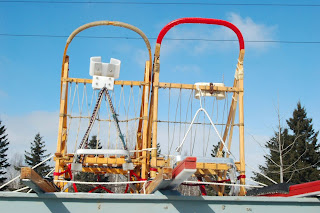Interesting lighting
All told, for our trip north, we spent three days in Harmony, Maine at the Lumberjack Lodges and two wonderful weeks at Baisley Lodges exploring the trails in the surrounding areas. We logged approximately 150 miles with the dogs either on the sled or skijoring. We also snowshoed, cross country skiied, attended the Can Am Crown Sled Dog races, had a wonderful dinner at Chez Charlotte in Edmunston, dined by the fire at Baisley Lodges with several Canadian and US mushers after the Can Am, and visited the Edmundston library to check email and post blog entries.Leaving the Excavator's lot
As many of you know, this was our second season visiting Baisley Lodges in St. Jacques, NB and we highly recommend it to both mushers and non mushers. The trails that Gino grooms in (with his prized Skandic) are excellent and total well over 100 miles in length. The variety of trails and scenery is simply stunning (as you can see in the photos throughout our recent blog entries). Distances range from the five mile Lynch Mountain Trail to thirty plus mile trails. Trail mileage is never a problem. There is very little snow mobile traffic. Last year, during a full seven days of visiting Baisley Lodges, we saw one snow mobile the entire time. This year, we saw two snowmobiles during our two full weeks at Baisley Lodges, both on a weekend run. Running early in the morning on the weekends is advised to minimize contact with snowmobiles. The two snowmobiles that we encounter while running the team were very polite and slowed way down and gave the team a wide berth as they passed.Gliding over a silent trail, behind a team of hard working sled dogs, listening as the birds call, animals rustle in the woods, and watching for animal tracks along the trail. This is the life we love.




















































